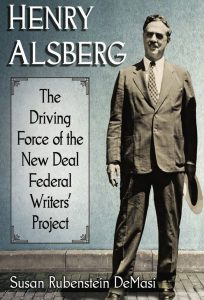 “The 1930s was the most creative period in American cultural life” claimed actress Toby Cole when I interviewed her shortly before her death at 92. I thought she was exaggerating because she had worked for the Federal Theatre Project (FTP) during the New Deal. But after reading Susan Rubenstein DeMasi’s absorbing biography of Henry Alsberg, who headed the Federal Writers Project (FWP), I’m inclined to agree. It is virtually impossible to imagine such inventive individuals as Alsberg and Hallie Flanagan, who headed the Federal Theater Project during the New Deal, being hired by government today—even in a Democratic administration.
“The 1930s was the most creative period in American cultural life” claimed actress Toby Cole when I interviewed her shortly before her death at 92. I thought she was exaggerating because she had worked for the Federal Theatre Project (FTP) during the New Deal. But after reading Susan Rubenstein DeMasi’s absorbing biography of Henry Alsberg, who headed the Federal Writers Project (FWP), I’m inclined to agree. It is virtually impossible to imagine such inventive individuals as Alsberg and Hallie Flanagan, who headed the Federal Theater Project during the New Deal, being hired by government today—even in a Democratic administration.
A rumpled bear of a man from a secular New York Jewish family, Alsberg was born in 1881 in New York and died in Palo Alto 89 years later after spending a lifetime necessarily hiding his homosexuality from all but radical friends like Emma Goldman.
DeMasi calls the 1920s “arguably his most active period, [when] he energetically segued from journalism to refugee relief work to theatrical pursuits to political endeavor,” but it is the work he did as head the Federal Writers Project for which, thanks to DeMasi’s book, as well as David A. Taylor’s 2009 Soul of People: The WPA Writers’ Project Uncovers Depression America, Alsberg will be gratefully remembered for the FWP’s volcanic output under his inspired leadership.
In 1934 Alsberg edited the large format book America Fights the Depression whose more than 200 photos showed the myriad of ways in which the new Civil Works Administration hired more than four million people to wage constructive war against the economic calamity during the winter of 1933-34.
It was probably on the strength of that book that WPA chief Harry Hopkins entrusted Alsberg to muster his own army of thousands of unemployed writers. Alsberg wanted to use that talent to reflect Americans back to themselves just as photographers of the Farm Security Administration, notably Dorothea Lange, Walker Evans, Gordon Parks, and Arthur Rothstein, were doing at the same time—even when that meant lancing popular mythology and telling the stories of those left in the dust.
The most famous outcome of the FWP was the now classic WPA guidebooks to all 48 states and many American cities. It also spawned hundreds of other books as well as transcripts of thousands of interviews including those with ex-slaves at the end of their lives and countless pages of research never published but now an invaluable resource to historians, ethnographers, folklorists and others.
Often difficult, utopian, and self-described as a “philosophical anarchist,” Alsberg was himself surprised to find himself working as an administrator within the government. A lifelong progressive in his politics, Alsberg had much to hide from the New Deal’s enemies, and DeMasi does a splendid job not only of resurrecting a secretive man’s life but delineating the reactionary forces in Congress that ultimately brought him and Hallie Flanagan down in a Communist witch hunt that foreshadowed the McCarthy era.
In her introduction, DeMasi admits that in writing her book, she fell in love with Alsberg. You will, too, in reading it.